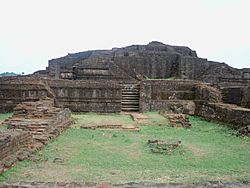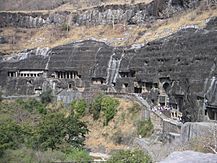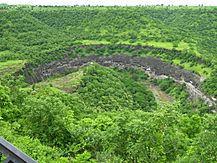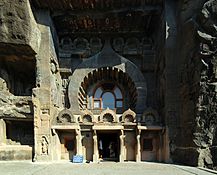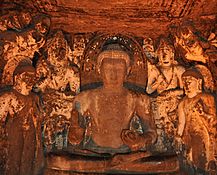Vakataka dynasty facts for kids
Quick facts for kids
Vakataka Empire
|
|||||||||||||||||||
|---|---|---|---|---|---|---|---|---|---|---|---|---|---|---|---|---|---|---|---|
| c. 250 CE– c. 500 CE | |||||||||||||||||||
|
|
|||||||||||||||||||
| Capital | Vatsagulma (Now Washim) | ||||||||||||||||||
| Common languages | Sanskrit Prakrit |
||||||||||||||||||
| Religion | Hinduism Buddhism Jainism |
||||||||||||||||||
| Government | Monarchy | ||||||||||||||||||
| Maharaja | |||||||||||||||||||
|
• 250–270
|
Vindhyashakti | ||||||||||||||||||
|
• 270–330
|
Pravarasena I | ||||||||||||||||||
|
• 475–500
|
Harishena | ||||||||||||||||||
| Historical era | Classical India | ||||||||||||||||||
|
• Established
|
c. 250 CE | ||||||||||||||||||
|
• Disestablished
|
c. 500 CE | ||||||||||||||||||
|
|||||||||||||||||||
| Today part of | India | ||||||||||||||||||
The Vakataka dynasty was an ancient Indian kingdom. It started in the Deccan Plateau around 250 CE. Their land stretched from central India to the south. It also went from the Arabian Sea in the west to eastern India. They were important rulers after the Satavahanas. They lived at the same time as the Gupta Empire in northern India.
The Vakataka dynasty was a Brahmin family. Not much is known about Vindhyashakti, who started the kingdom. His son, Pravarasena I, helped the kingdom grow a lot. The Vakataka family later split into different branches. One important event was when the Gupta Emperor Chandragupta II married his daughter into the Vakataka royal family. This helped them take over Gujarat. The Vakatakas were also known for supporting art, buildings, and writing. They built many public works. The famous rock-cut Ajanta Caves were made with their help.
Contents
The Vakataka Dynasty: Key Rulers and Branches
Vindhyashakti: The Founder
Vindhyashakti (around 250-270 CE) was the first ruler of the Vakataka dynasty. His name comes from the goddess Vindhyavasini. We don't know much about him. An old writing calls him the "banner of the Vakataka family." It also says he won many battles and had a large army. He ruled for about 20 years. Some historians think the Vakatakas came from a place called Amravati.
Pravarasena I: The Great Emperor
Pravarasena I (around 270-330 CE) was the next ruler. He made the Vakataka kingdom very powerful. He was the first Vakataka ruler to call himself a Samrat, meaning "universal ruler." He fought wars and expanded his kingdom. His rule stretched from central India to parts of southern India. He ruled for 60 years.
Pravarasena I followed the ancient Vedic religion. He performed many special ceremonies called Yajnas. These included four horse sacrifices, known as Asvamedhas. He also gave many gifts to priests during these ceremonies. He took the title Dharmamaharaja, meaning "great king of righteousness." Pravarasena I had four sons. He arranged for his son Gautamiputra to marry a princess from the powerful Bharashiva family. This marriage helped the Vakatakas. Gautamiputra died before his father. So, Pravarasena I was followed by his grandson, Rudrasena I. Another son, Sarvasena, started a new branch of the family in Vatsagulma.
Branches of the Vakataka Dynasty
After Pravarasena I, the Vakataka ruling family split into four parts. We know about two of these branches. They are the Pravarapura-Nandivardhana branch and the Vatsagulma branch.
Pravarapura-Nandivardhana Branch
This branch ruled from places like Pravarapura (now Paunar) and Nandivardhan (now Nagardhan). They had close family ties with the powerful Gupta Empire.
Rudrasena I
Rudrasena I ruled from Nandivardhana. Not much is known about his rule. Some historians debated if he was mentioned in another famous inscription. But it's now believed he was not the same person.
Prithivishena I
Rudrasena I was followed by his son, Prithivishena I (355-380 CE). He continued the family's rule.
Rudrasena II and Pravarasena II
Rudrasena II (380–385 CE) married Prabhavatigupta. She was the daughter of the famous Gupta King Chandragupta II. Rudrasena II died very soon after. His wife, Prabhavatigupta, ruled as a regent for their young sons for 20 years. During this time, the Vakataka kingdom was closely linked to the Gupta Empire.
Their son, Pravarasena II, later became king. He wrote a poem called Setubandha in a language called Maharashtri Prakrit. He also moved the capital from Nandivardhana to a new city he built, Pravarapura. Many copperplate writings from the Vakataka dynasty are from Pravarasena II's time. He is one of the most recorded ancient Indian rulers after Ashoka the Great.
Narendrasena and Prithivishena II
Pravarasena II was followed by Narendrasena (440-460 CE). Under him, the Vakataka influence spread to other parts of central India. Prithivishena II was the last known king of this branch. He ruled around 460-480 CE. After his death, his kingdom was likely taken over by Harishena from the Vatsagulma branch.
Vatsagulma Branch
The Vatsagulma branch was started by Sarvasena. He was the second son of Pravarasena I. King Sarvasena made Vatsagulma his capital. This city is now known as Washim in Maharashtra. This branch ruled the area between the Sahyadri Mountains and the Godavari River. They were important supporters of the Buddhist caves at Ajanta.
Sarvasena
Sarvasena (around 330 - 355 CE) also used the title Dharmamaharaja. He wrote a poem called Harivijaya in Prakrit. This poem was about the story of Krishna bringing a special tree from heaven. This work is now lost, but other writers praised it. He was followed by his son, Vindhyasena.
Vindhyasena
Vindhyasena (around 355 - 400 CE) was also known as Vindhyashakti II. We know about him from old copper plates found in Washim. These plates recorded a gift of a village. This was the first known land gift by a Vakataka ruler. He also used the title Dharmamaharaja. Vindhyasena defeated the ruler of Kuntala, a neighboring kingdom to the south. His son, Pravarasena II, followed him.
Pravarasena II
Pravarasena II (around 400 - 415 CE) was the next ruler. Not much is known about him. An inscription at Ajanta Caves says he was a great ruler. He died after a short rule. His young son, who was only 8 years old, became the next ruler.
Devasena
This unnamed ruler was followed by his son, Devasena (around 450 - 475 CE). His minister, Hastibhoja, mostly managed the kingdom. During Devasena's rule, a servant built a water tank called Sudarshana near Washim.
Harishena: The Last Great Ruler
Harishena (around 475 - 500 CE) followed his father Devasena. He was a great supporter of Buddhist art and culture. The famous Ajanta Caves, a World Heritage Site, are a lasting example of his work. An inscription at Ajanta says he conquered many regions. These included areas in the north, east, west, and south of his kingdom. Varahadeva, Harishena's minister, helped create Cave XVI at Ajanta. Three Buddhist caves at Ajanta (Caves XVI, XVII, and XIX) were carved and decorated during Harishena's time.
Harishena was followed by two rulers whose names are not known. The Vakataka dynasty likely ended around 500 CE. They were probably defeated by the Kalachuri kingdom.
Images for kids
See also
 In Spanish: Dinastía Vakataka para niños
In Spanish: Dinastía Vakataka para niños




